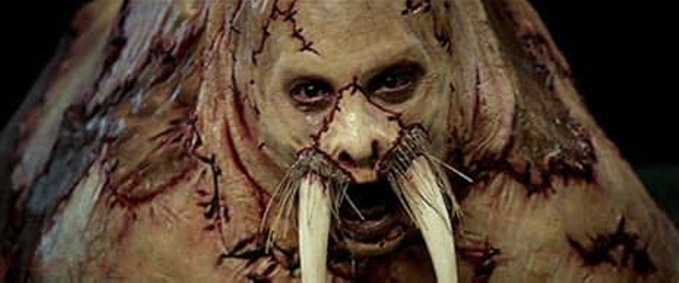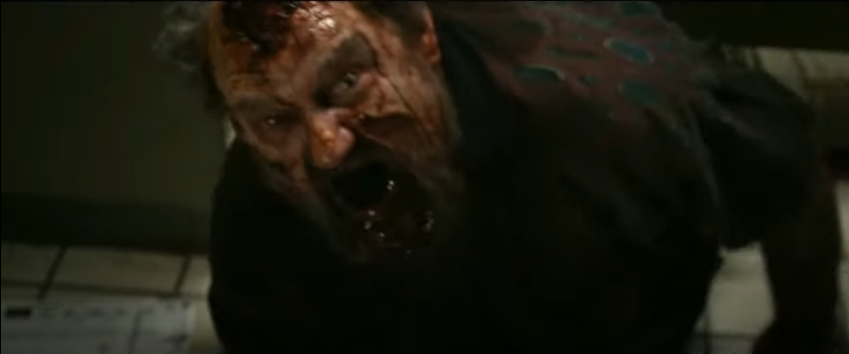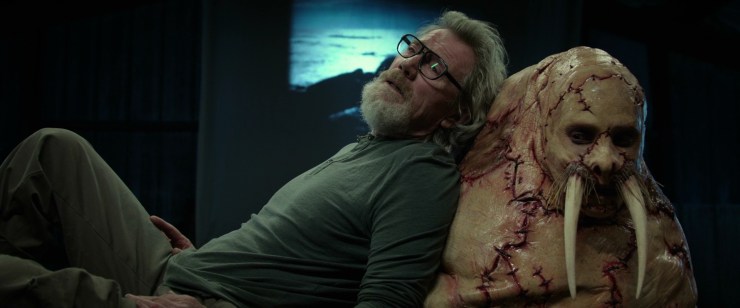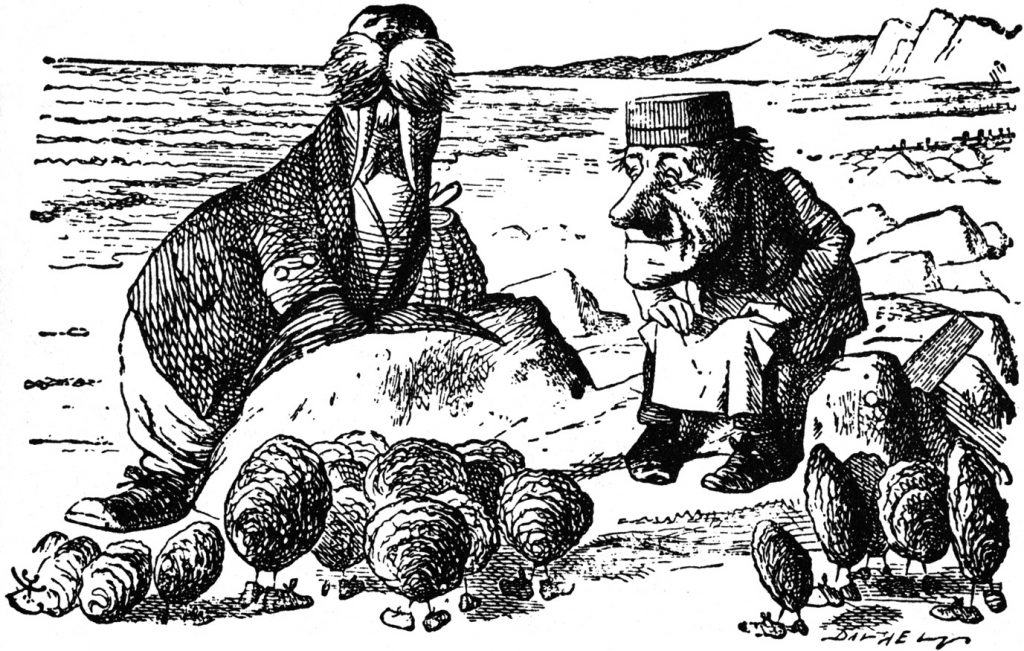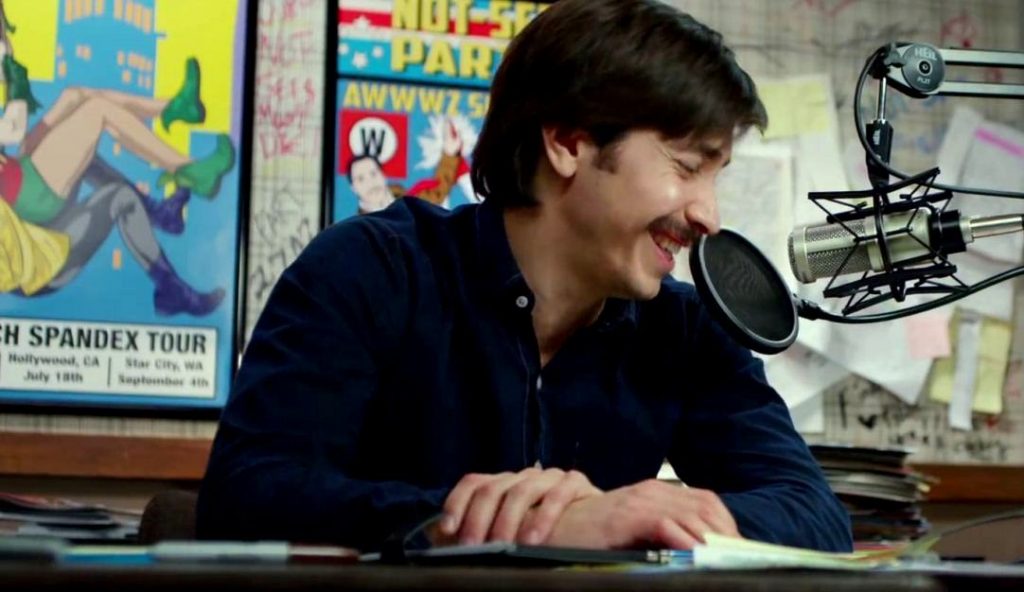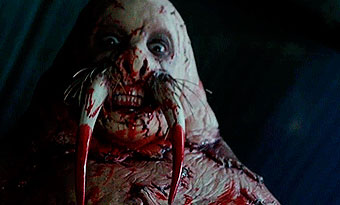The film opens with Wallace and Teddy who host a popular podcast where they discuss viral videos and interview internet celebrities. Wallace travels to Canada to interview someone, however upon arrival it is clear they have committed suicide. Annoyed he flew to Canada for nothing, he stumbles across a letter in a pub’s bathroom stall stating about interesting stories. Wallace calls Howard Howe and organises the interview; Howard tells the story of how he was lost at sea and ‘Mr. Tusk’, a walrus, saved his life, meanwhile he has drugged the tea Wallace was drinking. He awakes to find himself in a wheelchair with his leg amputated – the start of Howard’s plan to turn him into a walrus. Howard continues the transformation, until the walrus suit made from human skin and tusks from Wallace’s leg bones is complete. After, Howard dons his own walrus suit, and they engage in a fight and Wallace impales and kills Howard using the tusks. Wallace’s friends find him here and the film ends with him being left alive in captivity where they can visit him.
Within this film ‘Tusk’, I will discuss the use of animal representations and the psychological ramifications they had on a human’s psyche. Kevin Smith uses a blend of genres, primarily horror and comedy, in order to show the absurdity and incongruity of this distinct murder pattern. The animal solely featured is a walrus and they are not stereotypically associated with positive or negative connotations, so using this ambiguous animal, Smith manipulates their natural identity to fit any category, specifically that of brutality or horror. Furthermore, I will discuss the use of the physical gore and the grotesque which psychologically affects the viewers while using a lens of abjection and how visuals cause distress and discomfort. The film consists of themes of isolation and loneliness and the effects of abuse and the mental implications this can cause; Smith does this through levels of irony and film techniques such as sound, camera angles and mise-en-scene.
Visual imagery of the grotesque plays a key role in establishing the horror genre and creating the utmost disturbing atmosphere. When Wallace’s character has been put into the human-skin patchwork of the walrus costume, the initial response is real abjection, as it is visually repulsive and disturbing. Julia Kristeva describes this as ‘All crime, because it indicates the fragility of law, is abject, but premeditated crime, sly murder, hypocritical vengeance is still more so because they emphasise this exhibition of legal fragility’ so, we can see how Howard’s despicable crime can be classified as abject. This means that the viewers would be provoked to have a strong reaction to the presence of Wallace in the walrus suit, such as nausea. The imagery goes beyond human comprehension of what a person should look like and teeters on the possibility of life and death throughout; this is seen as the impossible conglomerate is still alive and breathing despite the many manipulations and disfigurements conducted to his body and after seeing the corpses of other victims sewn into walrus suits at the bottom of the enclave.
Kristeva believes that the manipulation of something living causes an abnormal awareness to the human consciousness, one where we feel disgust due to the teetering between states of life. In this still, the tight close-up is the first time we see this creature in a big reveal moment, where the mise-en-scene obscures any surrounding background so, the viewer is only able to look at the anguish caused to Wallace; it captures how we are staring life and death in the face in such a horrific way. Similar to zombies within ‘Zombieland’ which pivot between the existence between life and death, this would be cause for abjection because they elicit a physical grotesque reaction within the viewer. This figure closely resembles the still from ‘Tusk’ as they are both crawling and mangled and have undergone a physical transformation into abjection; transformation is a key horror element which consists of humans changing into something unprecedented and otherworldly.
Being so close to the subject elicits a physical reaction; it is difficult to look straight at it for the whole duration of the shot. This is because the closer proximity to it, we see the pain and destruction caused to another human being in the most traumatic way possible, causing the viewer to feel guilt and empathy. The human mind cannot fathom such trauma, so we subconsciously disassociate it with reality. Furthermore, the use of costuming also contributed to the feeling of unease and discomfort. This is because they were real hand-painted costumes, seen in the documentary, highlighting how this figure is within the realm of possibility. If Smith used a different route to portray the hideous creation, such as CGI, it would have lost the human aspect, relating to how we are portraying this human-animal relationship. Here, the boundaries between humans and animals have been eradicated as they significantly overlap; this broken-down distinction shows how similar man and animal is and the primal struggle one another faces. However, the dissimilarities encourage the viewer to feel great empathy for Wallace because of how unnatural this fate is for a human.
Kevin Smith himself said, ‘I just wanted to showcase Michael Parks in a fucked up story, where he could recite some Lewis Carroll and The Rime of the Ancient Mariner to some poor motherfucker sewn into a realistic walrus costume.’ This elaborates on how disturbing the director wanted to set the tone of the film as Park’s character’s dialogue consists of a children’s classic: Through the Looking-Glass by Carroll, specifically the internal poem ‘The Walrus and the Carpenter’ which was also the name of the Smith’s podcast episode where they initially conceived the idea for the film. This is disturbingly ironic as this is a children’s novel, but this film is not for child viewership. By using a poem meant for children to read, is twisted and sinister as it strips the innocence it carries because it is used in such a horrific context. The implications of a children’s poem within this realm of lived-in horror as a means to taunt Wallace is perverse because the narrative is always hopeful and optimistic where this cruel distortion is the opposite. The dynamic between the characters distinguishes the futility of innocence.
The similarities between the film’s still and the illustrated image from ‘Through the Looking-Glass’ is undeniably uncanny. Howard recites this particular poem to Wallace from the children’s novel showing a link to walruses themselves. He could be telling this just to exaggerate the connection, however it is eerily similar to their situation. The poem’s basic message consists of the deliberation of which character is worse morally; this links to our two main characters because we have a serial killer and an immoral person who produced a podcast to merely ridicule viral videos which lead to someone committing suicide due to the constant mockery. This showcases how this poem is used to highlight their individual negative characteristics. Specifically, walruses are used because of their barren arctic environment which is symbolic of loneliness. Loneliness and isolation can have damaging repercussions on someone’s mental psyche and here, we see Howard projecting his feelings onto a creature equally lonely. This psychological disturbance is what characterises a horror trope as the characters cannot distinguish reality like other people. Alternatively, because this is from Howard’s point of view, he may believe his warped perceptions of this catastrophe being fair and acceptable. This may be because of the trauma he has endured across his life which has led to severe mental health conditions.
Looking at this still, we see Howard leaning against Wallace insinuating a level of perceived control and adoration he has for the creature. In the background there is a projection of the seacoast and rocks in the forefront, the habitat of a typical walrus and the setting of the poem. Here, he is trying to recreate and emulate this scene because he believes his childish innocence and longing for companionship. His face does not show happiness, yet a yearning for the past and is somewhat melancholic. He believes that a wild walrus was his friend, and this human-animal relationship is what saved him, so this recreation has a sentimental emotional connection like that of what a typical pet has on people.
Black comedy is reminiscent throughout the film through absurdity and irony. A key element in horror is transformation however, Smith uses this for a comical purpose in some scenarios. For example, the defining feature of our protagonist is his moustache, which was pointed out numerous times and he even was referred to as ‘Moustache’ sometimes, but the defining feature for the transformation and ironically the title of the film, are the tusks which replace the moustache. This difference is humorous in a dark way because of the situational irony. Likewise, Wallace’s name is comedic because of the typical association and alliteration of ‘Wally the Walrus’ which is a well-known phrase or name given to a walrus. To hone this association in even further, the non-diegetic song which plays during the credits of the film is called ‘Oh Waly, Waly’ sang by Gerard Way. This is mocking Wallace’s character in a satirical way which is ironic as he created his living through mocking unfortunate people. So, using transformation and animals, we can infer comedy as the film is making references to his previous characteristics and warped them in a comical, absurd way.
In conclusion, a key element for disturbing horror tropes is using transformations from humans to (arguable) animals. This is because it lingers on what constitutes as natural and within the realm of possibility but on the other hand this transformation is something so horrific and outlandish it is unorthodox and disturbing. Another notoriously disturbing film which uses the same principle would be ‘The Human Centipede’ directed by Tom Six which causes immediate feelings of abjection (Kristeva). This film directly makes references to centipedes as the characters are tragically sewn together to make them look like a centipede. These horrific modifications and surgeries performed by the antagonists of both films allows us to see how incorporation of animals as references to their amalgamations highlights how mimicry of animals and allows for the viewer to associate it to something natural and notable.
Additionally, another horror/comedy film which incorporates irony for comedic effect is ‘Shaun of the Dead’ directed by Edgar Wright. Irony can be established immediately in the title of the film which is a pun on a classic horror ‘Dawn of the Dead’. Name changes are used retrospectively to highlight irony and draw attention to the puns which create airs of bathos. Also, colour is used for ironic effect when Shaun has ‘red’ on him, red being the leakage of his pen however, later the film begins to get gory when the zombies arrive and the colour red appears on him, which would be blood splatters. Therefore, comedy is derived from puns and changes to the protagonist’s characteristics, similar to elements used in ‘Tusk’.
Ultimately, in ‘Tusk’ horror and comedy tropes are used in conjunction to create a disturbing and unsettling atmosphere which has periodically comedic aspects to create releases of tension. Specifically a walrus is incorporated to signify loneliness due to its desolate icy landscape – this has ties to horror as loneliness categories the depletion of mental health which is symbolic of Howard as a character and the trauma he has endured. Also, on the opposite end of the spectrum it is incongruous because the film associate’s walruses with heroic tendencies and loyalty like a personal pet. However, the viewer understands this absurd expectation which contributes to the idea of Howard being a depraved sociopathic murderer because of his forged connections which is not realistic. Alternatively, the incongruity is an attribute to the dark humour of the film because it subverts viewers expectations of serial killers as this has never been seen before. The use of the grotesque and abjection makes the film memorable because the imagery is dissimilar to any other film. Leaving this film, the viewer will have a distinct association between walruses and horror which did not exist previously.
Further reading:
- Lewis Carroll – ‘Through the Looking Glass’ Walrus and the Carpenter
- Kevin Smith’s Podcast episode – ‘The Walrus and the Carpenter’
- Julia Kristeva – ‘Approaching Abjection’
- John Miller – ‘Walrus’
Bibliography:
- A25, Tusk | Official Trailer HD | A25, online video recording, YouTube, 26 July 2014, https://www.youtube.com/watch?v=BCQJnOn0ru0 [accessed 21 January 2021]
- Fleischer, Ruben, Dir, Zombieland (Columbia Pictures, 2009)
- Kristeva, Julia, ‘Approaching Abjection’, from Powers of Horror: An Essay on Abjection (New York: Columbia University Press, 1982), 1–30. Source: Oxford Literary Review, Vol. 5, No. 1/2 (1982), pp. 125-149
- Mac, Fleetwood, Fleetwood Mac – Tusk (Official Music Video), online video recording, YouTube, 27 September 2018, https://www.youtube.com/watch?v=ATMR5ettHz8 [accessed 21 January 2021]
- Robert, Michael, Gerard Way – The Water is Wide (Oh Waly Waly) LYRICS, online video recording, YouTube, 4 December 2014, https://www.youtube.com/watch?v=fLOnVw-EdJo [accessed 21 January 2021]
- Romero, George. A, Dir, Dawn of the Dead – (Laurel Group, 1978)
- Six, Tom, Dir, The Human Centipede (Blitzkrieg Distribution, 2010)
- Smith, Kevin, Dir, Tusk (SModcast Pictures 2014)
- Smith, Kevin, THE ROOTS OF TUSK (so far), (2013) <http://silentbobspeaks.com/?p=561 > [accessed 21 January 2021].
- Smith, Kevin, Walrus Yes: The Making of Tusk, online video recording, YouTube, 19 September 2019, https://www.youtube.com/watch?v=h2IKoonFHJc [accessed 21 January 2021]
- SModcast, SModcast 259: The Walrus and The Carpenter, (2013) <https://www.mixcloud.com/SModCast/smodcast-259-the-walrus-and-the-carpenter/> [accessed 21 January 2021].
- Wright, Edgar, Dir, Shaun of the Dead (Universal Pictures 2004)
